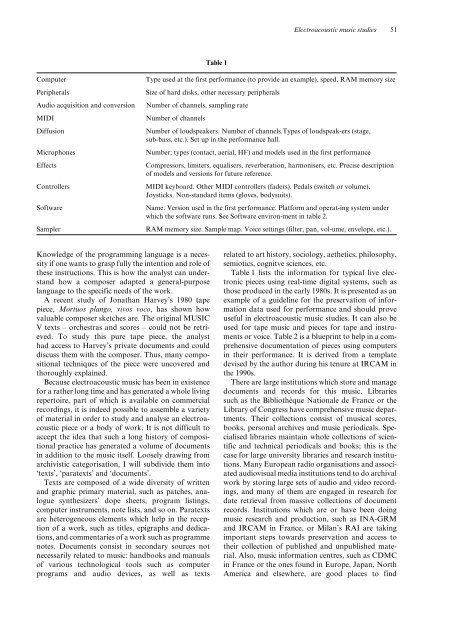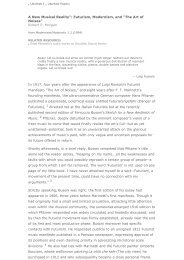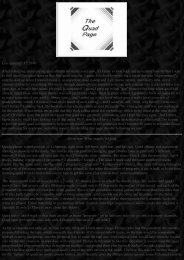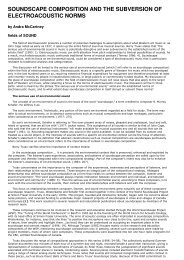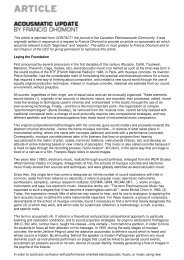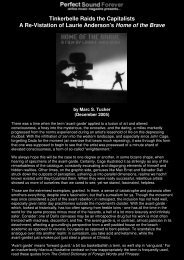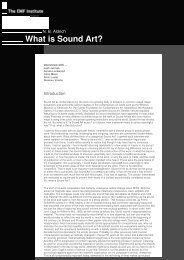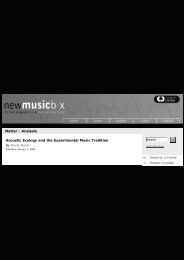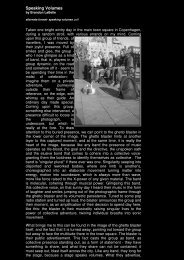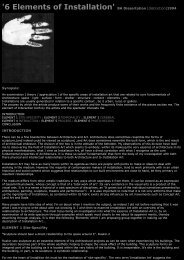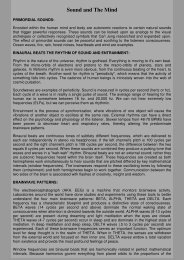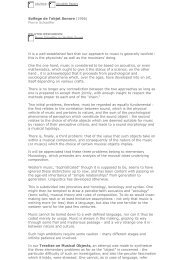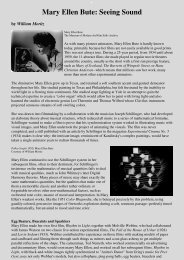Electroacoustic music studies and the danger of loss - Cambridge ...
Electroacoustic music studies and the danger of loss - Cambridge ...
Electroacoustic music studies and the danger of loss - Cambridge ...
You also want an ePaper? Increase the reach of your titles
YUMPU automatically turns print PDFs into web optimized ePapers that Google loves.
<strong>Electroacoustic</strong> <strong>music</strong> <strong>studies</strong> 51Table 1ComputerPeripheralsAudio acquisition <strong>and</strong> conversionMIDIDiffusionMicrophonesEffectsControllersS<strong>of</strong>twareSamplerType used at <strong>the</strong> first performance (to provide an example), speed, RAM memory sizeSize <strong>of</strong> hard disks, o<strong>the</strong>r necessary peripheralsNumber <strong>of</strong> channels, sampling rateNumber <strong>of</strong> channelsNumber <strong>of</strong> loudspeakers. Number <strong>of</strong> channels.Types <strong>of</strong> loudspeak-ers (stage,sub-bass, etc.). Set up in <strong>the</strong> performance hall.Number; types (contact, aerial, HF) <strong>and</strong> models used in <strong>the</strong> first performanceCompressors, limiters, equalisers, reverberation, harmonisers, etc. Precise description<strong>of</strong> models <strong>and</strong> versions for future reference.MIDI keyboard. O<strong>the</strong>r MIDI controllers (faders). Pedals (switch or volume).Joysticks. Non-st<strong>and</strong>ard items (gloves, bodysuits).Name. Version used in <strong>the</strong> first performance. Platform <strong>and</strong> operat-ing system underwhich <strong>the</strong> s<strong>of</strong>tware runs. See S<strong>of</strong>tware environ-ment in table 2.RAM memory size. Sample map. Voice settings (filter, pan, vol-ume, envelope, etc.).Knowledge <strong>of</strong> <strong>the</strong> programming language is a necessityif one wants to grasp fully <strong>the</strong> intention <strong>and</strong> role <strong>of</strong><strong>the</strong>se instructions. This is how <strong>the</strong> analyst can underst<strong>and</strong>how a composer adapted a general-purposelanguage to <strong>the</strong> specific needs <strong>of</strong> <strong>the</strong> work.A recent study <strong>of</strong> Jonathan Harvey’s 1980 tapepiece, Mortuos plango, vivos voco, has shown howvaluable composer sketches are. The original MUSICV texts – orchestras <strong>and</strong> scores – could not be retrieved.To study this pure tape piece, <strong>the</strong> analysthad access to Harvey’s private documents <strong>and</strong> coulddiscuss <strong>the</strong>m with <strong>the</strong> composer. Thus, many compositionaltechniques <strong>of</strong> <strong>the</strong> piece were uncovered <strong>and</strong>thoroughly explained.Because electroacoustic <strong>music</strong> has been in existencefor a ra<strong>the</strong>r long time <strong>and</strong> has generated a whole livingrepertoire, part <strong>of</strong> which is available on commercialrecordings, it is indeed possible to assemble a variety<strong>of</strong> material in order to study <strong>and</strong> analyse an electroacousticpiece or a body <strong>of</strong> work. It is not difficult toaccept <strong>the</strong> idea that such a long history <strong>of</strong> compositionalpractice has generated a volume <strong>of</strong> documentsin addition to <strong>the</strong> <strong>music</strong> itself. Loosely drawing fromarchivistic categorisation, I will subdivide <strong>the</strong>m into‘texts’, ‘paratexts’ <strong>and</strong> ‘documents’.Texts are composed <strong>of</strong> a wide diversity <strong>of</strong> written<strong>and</strong> graphic primary material, such as patches, analoguesyn<strong>the</strong>sizers’ dope sheets, program listings,computer instruments, note lists, <strong>and</strong> so on. Paratextsare heterogeneous elements which help in <strong>the</strong> reception<strong>of</strong> a work, such as titles, epigraphs <strong>and</strong> dedications,<strong>and</strong> commentaries <strong>of</strong> a work such as programmenotes. Documents consist in secondary sources notnecessarily related to <strong>music</strong>: h<strong>and</strong>books <strong>and</strong> manuals<strong>of</strong> various technological tools such as computerprograms <strong>and</strong> audio devices, as well as textsrelated to art history, sociology, ae<strong>the</strong>tics, philosophy,semiotics, cognitve sciences, etc.Table 1 lists <strong>the</strong> information for typical live electronicpieces using real-time digital systems, such asthose produced in <strong>the</strong> early 1980s. It is presented as anexample <strong>of</strong> a guideline for <strong>the</strong> preservation <strong>of</strong> informationdata used for performance <strong>and</strong> should proveuseful in electroacoustic <strong>music</strong> <strong>studies</strong>. It can also beused for tape <strong>music</strong> <strong>and</strong> pieces for tape <strong>and</strong> instrumentsor voice. Table 2 is a blueprint to help in a comprehensivedocumentation <strong>of</strong> pieces using computersin <strong>the</strong>ir performance. It is derived from a templatedevised by <strong>the</strong> author during his tenure at IRCAM in<strong>the</strong> 1990s.There are large institutions which store <strong>and</strong> managedocuments <strong>and</strong> records for this <strong>music</strong>. Librariessuch as <strong>the</strong> Bibliothèque Nationale de France or <strong>the</strong>Library <strong>of</strong> Congress have comprehensive <strong>music</strong> departments.Their collections consist <strong>of</strong> <strong>music</strong>al scores,books, personal archives <strong>and</strong> <strong>music</strong> periodicals. Specialisedlibraries maintain whole collections <strong>of</strong> scientific<strong>and</strong> technical periodicals <strong>and</strong> books; this is <strong>the</strong>case for large university libraries <strong>and</strong> research institutions.Many European radio organisations <strong>and</strong> associatedaudiovisual media institutions tend to do archivalwork by storing large sets <strong>of</strong> audio <strong>and</strong> video recordings,<strong>and</strong> many <strong>of</strong> <strong>the</strong>m are engaged in research fordate retrieval from massive collections <strong>of</strong> documentrecords. Institutions which are or have been doing<strong>music</strong> research <strong>and</strong> production, such as INA-GRM<strong>and</strong> IRCAM in France, or Milan’s RAI are takingimportant steps towards preservation <strong>and</strong> access to<strong>the</strong>ir collection <strong>of</strong> published <strong>and</strong> unpublished material.Also, <strong>music</strong> information centres, such as CDMCin France or <strong>the</strong> ones found in Europe, Japan, NorthAmerica <strong>and</strong> elsewhere, are good places to find


